#pleuronectiform
Explore tagged Tumblr posts
Text



Flounder changing color on different surfaces By: USFWS From: The Science of Zoology 1966
908 notes
·
View notes
Text
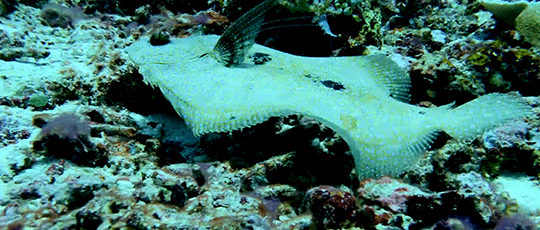
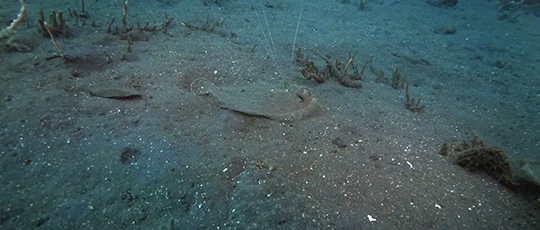
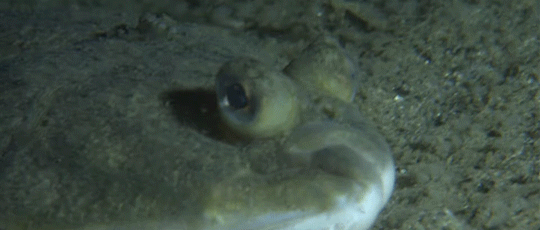

Flounders are demersal fish, meaning they live and feed on or near the bottom of bodies of water. Their distinctive shape is an obvious benefit for this lifestyle. ©Nature Footage
77 notes
·
View notes
Text
Taxonomy Tournament: Fish

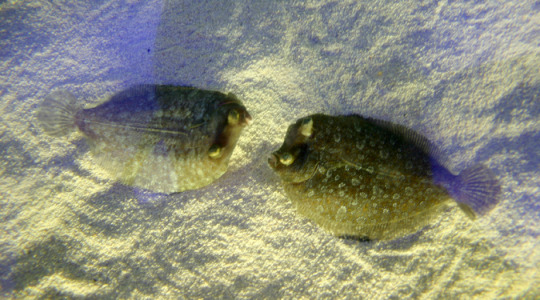
Carangiformes. This order contains the aggressively predatory dolphinfishes, and remoras, which have a sucker-like dorsal fin that allows them to attach to a larger host animal.
Pleuronectiformes. This order is made up of flatfishes, wuch as the flounder and halibut.
#animals#biology#polls#poll tournament#zoology#remoras#fish#flounders#halibut#Carangiformes#Pleuronectiformes#0x7cv0x83#animal tournament#Animal Tournament Round 1
29 notes
·
View notes
Text
Australian Pokemon
Another set of fakemon from my Goorda region based on a mix of Australia and Aotearoa/New Zealand. Previous posts: single stages, non-natives, regional standards, creepy lines, regional variants, birds, early-game standards, misc 2, misc 1, starter variants, starters.
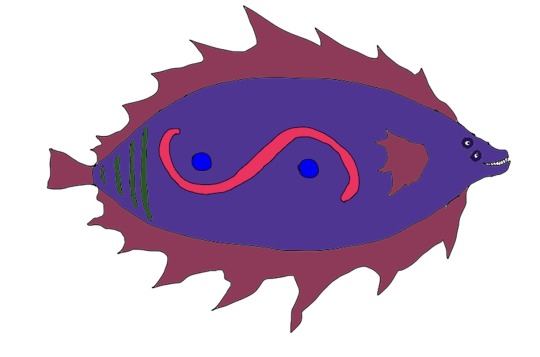
Plat, the Land Flounder Pokemon, poison-type. These fish Pokemon have adapted to life on land. They bury themselves under sand with only their eyes exposed. When something steps on the hidden Plat, it uses the razor-sharp edges of its fins to inject poison into the prey.
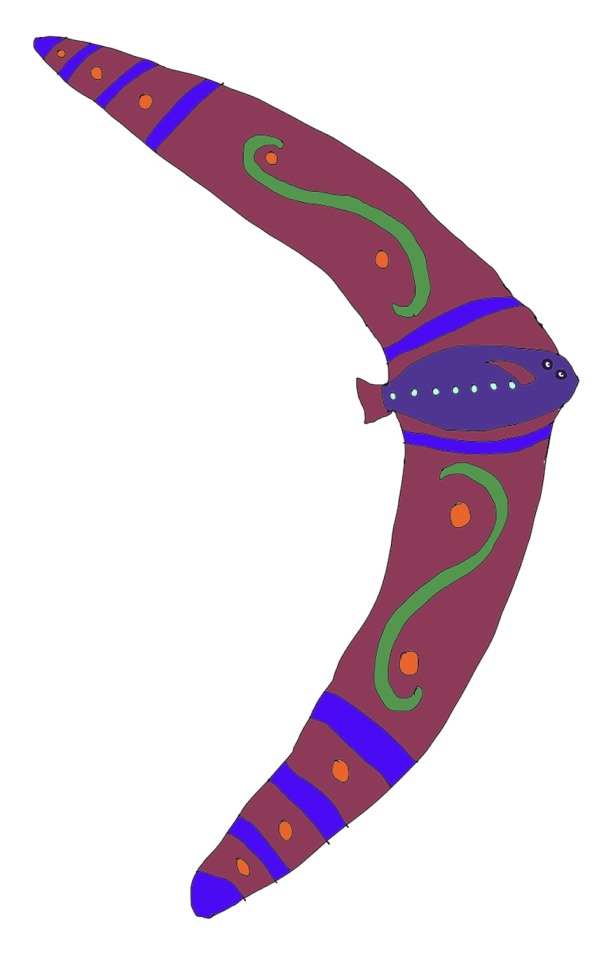
Plat evolves to Plumerang, the Sky Flounder Pokemon, flying/poison-type. Unlike the landlocked, ambush predator Plat, Plumerang has learned to fly through the sky by spinning its body in a strange, looping motion. They chase after flying prey, using their razor-sharp fins to poison them. When the poison causes the prey to fall out of the sky, Plumerang will descend on them. Humans in the past trained Plumerang to act as living weapons.
Plat and Plumerang are based on flounders. Plat is also based on the stonefish, an extremely venomous Australian fish that is easy to step on due to its camouflage. Plumerang is based on flying fish and boomerangs. Much like how Plumerang was used as a weapon, boomerangs were originally invented to act as weapons. Their name comes from "Pleuronectiformes" (the flounder family) plus "flat" and "boomerang".

Tormite, the Termite Pokemon, bug-type. Tormite live and work in giant hives made from soil blued together with saliva. They mix together explosive chemicals in their abdomens. They can release these chemicals from their rear ends, spending them rocketing mandibles-first at enemies.
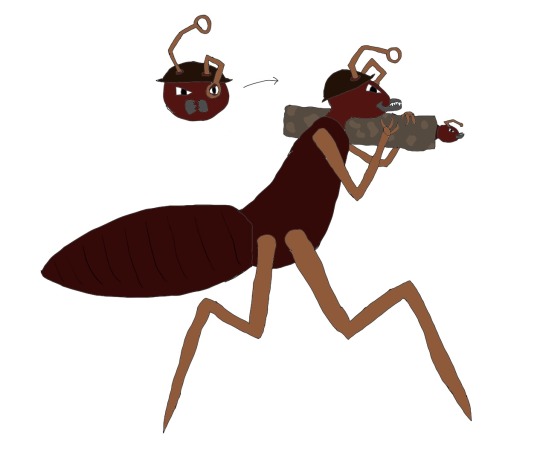
Tormite evolves to Myrpaga, the Army Ant Pokemon, bug-type. Myrpaga are the primary defenders of the hive. They create tubes out of dirt and plant material glued together with saliva. A Tormite sits in this tube, which is used to fire it at threats to the hive as a living missile. Myrpaga's antennae contain lenses that it uses to help aim.

Female Myrpaga evolves to Myrmartill, the Walking Hive Pokemon, bug-type, if said Myrpaga levels up when the trainer has 5 Tormite on their team. Rarely seen in the wild, Myrmartill only appear when the hive has to relocate. It carries the hive on its back and defends itself with twin turrets that fire barrages of Tormite at enemies. Nothing will get in the way of Myrmartill as it looks for a new place for the hive to live.
The Tormite line are based on ants and termites (which I genuinely thought were related to each other. Turns out they aren't) mixed with military technology. Chemical weapons are commonly used by ants and termites in defense of their hives. Tormite is a living rocket-propelled grenade and takes influence from the bombardier beetle. Myrpaga and Myrmartill are based on army ants. True army ants are native to South America, but a species with similar behavior is native to Australia. Myrpaga is a a soldier holding a rocket launcher while Myrmartill is a mix of armored troop transport and artillery cannon. Tormite comes from "termite", "torment", and "torpedo". Myrpaga comes from "myrmex" (Grrek for ant") and "RPG". Myrmartill comes from "myrmex" and "artillery".

Sparquoll, the Sparking Pokemon, fire/electric-type. When Sparquoll runs, sparks are released from its feet that leave a trail of embers in its wake. It will climb trees to shock bird Pokemon out of the air, then finish them with a burst of flames.

Sparquoll evolves to Sparkinina, the Sparking Pokemon, fire/electric type. Sparkinina has a unique organ that functions both as a flame sac and generator of electricity. This allows Sparkinina to produce both intense flames and powerful electric shocks. It chases down prey and immobilizes it with electric shocks, before dealing a fiery bite as a finishing blow.
Sparquoll and Sparkinina are based on quolls and Tasmanian devils, carnivorous marsupials that are related to each other. Spark can refer both to fire and electricity, so a fire/electric type seems like a fairly obvious combination. Their names come from "spark", "quoll", and "purinina" (the Palawa Kani language word for Tasmanian devils). Also, Sparkinia learns Twister as a shout-out to Loony Tunes.
I have some more fakemon in the works, so another post should come out within a few days
#pokemon#fakemon#australia#aotearoa#new zealand#original pokemon#flounder#boomerang#termite#ants#army ants#quoll#tasmanian devil#art#new artist#artists on tumblr#artblr#drawing#digital art
24 notes
·
View notes
Text
Endemic fauna from a new world-building project (Chortis: Territory of Magic)


Inspired by projects such as Tales of Kaimere and Hollow Earth (by j_stocky).
Minor inspiration from the Monster Hunter series
It involves some soft spec (this includes impossible stuff such as magic but that is for another day)
Taxa listed:
Keythongidae (family of flightless pterosaurs, only extant species is 𝘒𝘦𝘺𝘵𝘩𝘰𝘯𝘨 𝘬𝘦𝘺𝘵𝘩𝘰𝘯𝘨, the keythong)
Vormes (secondarily-terrestrial mosasaurs derived from Halisaurines, most are venomous) Top to bottom: 𝘈𝘳𝘦𝘯𝘢𝘷𝘺𝘳𝘮𝘪𝘴 𝘨𝘪𝘨𝘢𝘥𝘦𝘬𝘵𝘦𝘴 (Horned sandwyrm), 𝘔𝘰𝘳𝘵𝘰𝘷𝘺𝘳𝘮𝘪𝘴 𝘤𝘩𝘰𝘳𝘪𝘴𝘵𝘰𝘨𝘯𝘢𝘵𝘩𝘶𝘴 (Olgoi-khorkoi)
Hydroherperia (clade of aquatic herperians, biarmosuchian-derived amniotes) 𝘗𝘴𝘦𝘶𝘥𝘰𝘭𝘢𝘨𝘪𝘢𝘤𝘳𝘶𝘴 𝘱𝘶𝘳𝘴𝘶𝘵𝘰𝘳 (Sea laggie)
Pseudodracones (clade of derived weigeltisaurian reptiles) 𝘛𝘳𝘪𝘵𝘰𝘯𝘢𝘱𝘦𝘪𝘭𝘪𝘴 𝘷𝘰𝘭𝘢𝘯𝘴 (Lesser andeda)
Antiquovivernes (clade of winged sharovipterygians) 𝘈𝘶𝘳𝘦𝘰𝘷𝘪𝘷𝘦𝘳𝘯𝘪𝘴 𝘷𝘶𝘭𝘨𝘢𝘳𝘪𝘴 (common antique wyvern)
Selenanodontia (clade of omnivorous or herbivorous aquatic stem-pangolins) 𝘏𝘺𝘥𝘳𝘰𝘤𝘢𝘮𝘦𝘭𝘪𝘹 𝘨𝘪𝘨𝘢𝘴 (Sea camel)
Cetodracones (secondarily-aquatic hexascelidans, accidentally wrote Cetodraconidae instead) 𝘙𝘶𝘣𝘳𝘰𝘤𝘦𝘵𝘰𝘥𝘳𝘢𝘤𝘰 𝘢𝘤𝘢𝘯𝘵𝘩𝘶𝘳𝘶𝘴 (Ruby dragonwhale)
Dyptosauria (ichthyosaur-convergent sauropodomorph dinosaurs related to 𝘌𝘰𝘳𝘢𝘱𝘵𝘰𝘳) Stenellasaura caerulea (Muotopara)
Actual ichthyosaurs are extinct on Chortis
Pseudophocoidea (superfamily of aquatic feliforms related to Herpestoidea)
Thalassotigris umbra (Northern sea panther)
Domplerichthyidae (family of omnivorous pelagic mola-like pleuronectiforms/flatfish)
Domplerichthys hadeli (Giant critterfish)
15 notes
·
View notes
Note
hi adalyn :] (? i hope i spelled that right) here's a fish

asking random questions because why not so what's your fav kind of drink? are u a coffee person? 🤔 oki love you byee 🫶
hi aspen ^_^ (you spelled it right btw)
thank you for the fish. idk what species it is (or if it's even meant to represent any actual species) but it's 1000% a flatfish/flounder of the order Pleuronectiformes.
answering your random question(s), I've never actually had coffee so idk if I'd like it or not, but is smells nice :]. I am a tea girlie tho (my favs are mint tea and chamomile tea). also love love love hot cocoa/chocolate milk. for non-warm drinks I also really really like lemonade 😌. oki byeee luv u 2 🫶
2 notes
·
View notes
Text
*about to ask my surgeon to put both my nipples back on one side* are you familiar with the order pleuronectiformes?
4 notes
·
View notes
Text
The curious fish that is called the hogchoker, Trinectes maculatus, is one of the few true flatfishes or pleuronectiforms, that are encountered in the aquarium trade with any regularity. In North America, where the species is native - for it is distributed from Massachusetts down to Panama - wild caught hogchokers turn up in retailers tanks fairly regularly, where they are usually sold as 'freshwater flounders'. Elsewhere else, this species is quite an infrequent import, and those flatfish that are explicitly traded as freshwater soles or flounders, at least in Europe, are more likely to belong to truly freshwater species indigenous to tropical South America, Asia and Australasia.
None of them is imported with great regularity, but in North America, it is wild caught juvenile hogchokers that are the flatfishes most often traded as a freshwater fish. This is not entirely accurate, because although the mature hogchokers can be found far upstream, juveniles are more strictly brackish fishes in the wild, inhabiting only estuarine waters during the summer months. Hogchokers are almost always sold when they are small individuals, for which a brackish setup would be more authentic. Juvenile hogchokers actually do survive and grow in freshwater environments, but such is suboptimal for their growth rate, and this is because freshwater creates higher metabolic stresses for them. Ideally, little hogchokers should be maintained in mildly brackish aquaria, and at a temperture of perhaps 22-26 degrees centigrade, based on the summer water temperatures that wild hogchokers this size would regularly encounter in their natural habitats.
Adult hogchokers show no preferences of salinity at such temperatures, being fine at a specific gravity of 0, or freshwater, upward to 1.02. in parts of their range, wild hogchokers experience water temperatures that may be quite low during the wintertime, but rising as high as standard tropical aquariums in the summertime. When they are kept at a temperture of 15 degrees, hogchokers grow best at a specific gravity of 1.01 to 1.02. Curiously, at the warmer temperatures that wild hogchokers might encounter in the southern part of their distribution, they puts on more weight when they are living in freshwater conditions.
On average, the hogchoker grows only to about 10 centimeters or 4 inches long, although individual fishes of twice this length are recorded, reaching a length of 20 centimeters, or 8 inches. These are small flatfishes, and they take only small prey in the wild, where they consume annelids, arthropods, and molluscs. Trinectes may need acclimatising to a frozen captive diet, but this can certainly be done, and they consume suitably sized meaty morsels. It is unlikely they will adjust to eating dried rather than defrosted foodstuffs, although it is not exactly unknown
The hogchoker is common on soft, sandy bottoms where it burrows itself in classic flatfish style, and it is also rokerant of still finer grained mud or silt bottoms. Such a fine substrate should be replicated in the aquarium, because hogchokers use the substrate to conceal themselves and this makes feel safe and relaxed. Flatfishes may be bothered or even injured by fishes that bite at the substrate, or are highly active at the bottom of the water column. Naturally, as predators, hogchokers in the aquarium may themselves consume small tankmates, so cohabitants must be too large for the flounders to see as prey.
By and large, however, hogchokers are not in the least confrontational by nature, and they may be considered reasonably indifferent to the activities of other fishes, using the water overhead in the same aquarium Although hogchokers camouflage themselves well, and are not very active, this very crypsis and their fascinating, asymmetrical anatomy make them a great, quiet oddball species, for those who accept these fish have specific care needs in our home tanks
#hogchoker#Trinectes maculatus#freshwater flounder#oddballs#misunderstood fish#brackish fishes#coldwater tropicals#freshwater flatfish
0 notes
Text
Flat Fish
Flatfish: Masters of Disguise Comment Suggest edit Edit from here
Flatfish, also known as flatfishes or pleuronectiformes, are a fascinating group of fish that have adapted to life on the ocean floor. Their most striking feature is their flattened body, which allows them to lie camouflaged on the seabed. This unique adaptation has enabled them to thrive in a variety of marine environments, from shallow coastal waters to the deep sea.
Physical Adaptations
Flatfish undergo a remarkable transformation during their development. As larvae, they are symmetrical, with eyes on both sides of their head. However, as they grow, one of their eyes migrates to the opposite side of their body. This process, known as metamorphosis, results in a flat body with both eyes on the same side. The side with the eyes is called the ocular side, while the blind side is called the blind side.
The flattening of the body is accompanied by other adaptations that help flatfish blend in with their surroundings. Their skin is often pigmented to match the color and texture of the seabed, making them virtually invisible to predators and prey. Some species even have the ability to change color rapidly to adapt to different environments.
Habitat and Behavior
Flatfish are found in all of the world's oceans, from the Arctic to the Antarctic. They inhabit a variety of habitats, including sandy bottoms, mudflats, and rocky reefs. Some species are demersal, meaning they live on or near the bottom of the ocean, while others are pelagic, living in the open water.
Flatfish are typically solitary animals, although some species may form schools. They are carnivores and feed on a variety of prey, including small fish, crustaceans, and worms. Many flatfish use their flattened bodies to ambush their prey from hiding places in the sand or mud.
FOR MORE UPDATES CLICK : fishingproo.com/flat-fish/
0 notes
Text
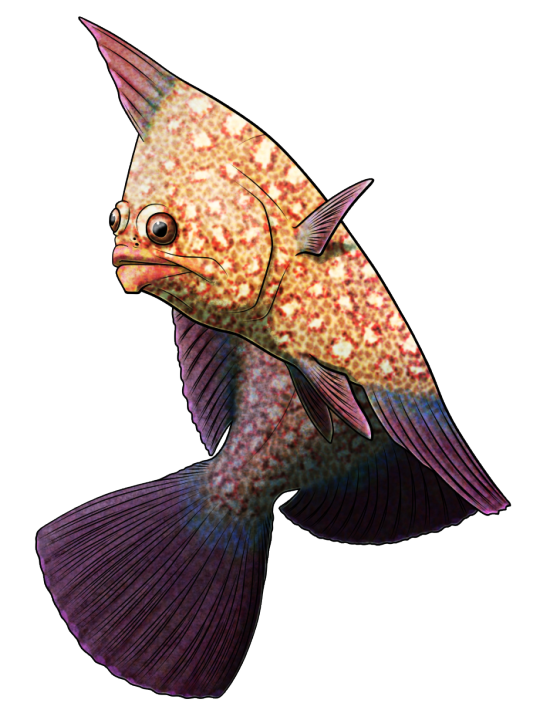
Strange Symmetries #18: Flat Fish Friday
Modern flatfish are characterized by their highly asymmetrical skulls, with both eyes positioned on just one side of their head. They aren't actually born this way, but instead they undergo "eye migration" as juveniles, twisting up their skulls to bring one eye across the top of the head.
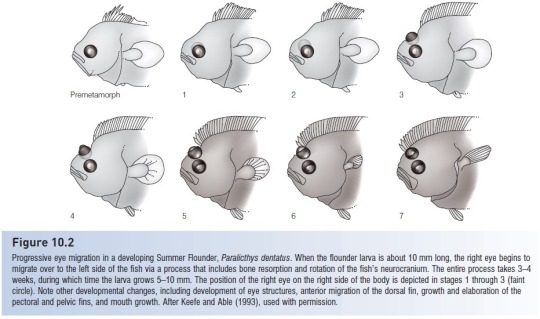
Progressive eye migration in a developing Summer Flounder, Paralicthys dentatus. From Helfman et al (2009). The diversity of fishes. 2nd ed., Wiley-Blackwell.
This bizarre arrangement is the result of flatfish adapting to life laying flat on the seafloor, but instead of slowly widening and flattening themselves out they took an evolutionary "shortcut" by simply tipping their tall narrow bodies over onto one side. Initially this would have left one of their eyes unusable, but random mutations causing slightly asymmetrical skulls would have rapidly become highly advantageous to the earliest members of this lineage – and over time they just got wonkier and wonkier.
We've even found fossils of early flatfish in the "halfway there" stage of their evolution!
Amphistium paradoxum lived in what is now northern Italy during the Eocene, around 50-48 million years ago. About 20cm long (~8"), it had one eye partially migrated towards the top of its head, but not all the way around yet, showing a transitional state between its bilaterally symmetric ancestors and its more twisted-skulled modern relatives.
Unlike most modern flatfish Amphistium came in both "right-eyed" and "left-eyed" forms in equal numbers, suggesting that a genetic preference for a specific side also hadn't developed yet.
———
NixIllustration.com | Tumblr | Twitter | Patreon
#science illustration#strange symmetries#paleontology#paleoart#palaeoblr#amphistium#pleuronectiformes#flatfish#actinopterygii#fish#art#flat fuck friday
348 notes
·
View notes
Text
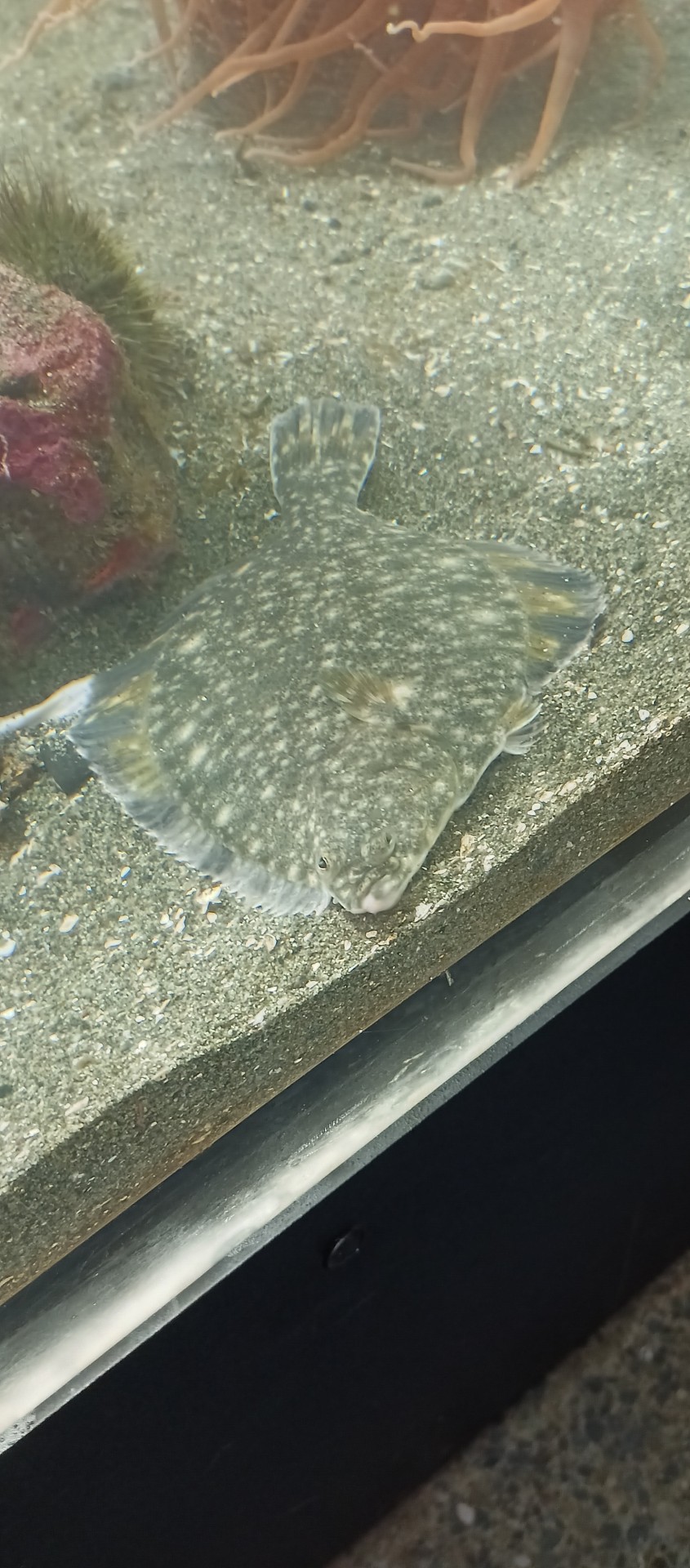
Starry flounder (Platichthys stellatus)
#starry flounder#eukarya#animalia#chordates#actinopterygii#pleuronectiformes#pleuronectidae#platichthys#platichthys stellatus#p. stellatus#flatfish#flounder
13 notes
·
View notes
Text

Amphistium
Amphistium — вимерлий рід променеперих риб ряду Камбалоподібні (Pleuronectiformes). Типовий вид — Amphistium paradoxum. Він вважається базальною формою камбалоподібних та перехідною формою від окунеподібних риб. На відміну від сучасних камбалових, у Amphistium очі не повністю зміщені на одну сторону голови, зокрема одне око розміщене на верхній частині голови.
Повний текст на сайті "Вимерлий світ":
https://extinctworld.in.ua/amphistium/
#amphistium#fish#pleuronectiformes#ua#actinopterygii#eocene#italy#verona#art#paleontology#paleoart#prehistoric#палеоарт#палеонтологія#ukraine#ukrainian#prehistory#science#illustration#daily#digital art#creatures#extinct#fossils#україна#мова#українська мова#український тамблер#арт#риби
8 notes
·
View notes
Text
Uncharismatic Fact of the Day
Hey everyone! In an attempt to bring a little more fun education, I’m going to start posting a daily fun fact in addition to our usual species-focused posts. Our first fun fact:
Flounders, a group of fish famous for their sideways appearance, don’t start out that way! As hatchlings they have one eye on each side of their head, as most animals do. Then, as they get older and become bottom-dwellers, one eye migrates to the other side of their body! The side that becomes their ‘top’ is based on which way the flounder leans while it swims as a juvenile.
youtube
(Video credit: Dr. Alexander Schreiber, flatfish metamorphosis begins at 0:26)
46 notes
·
View notes
Photo


Hunter flounder are easy enough to see when they’re swimming, but what about the one that didn’t move? BBC Earth
17 notes
·
View notes
Photo

The Baltic flounder (Platichthys solemdali) is a newly-discovered flatfish species, and according to researchers is the first endemic fish known from the Baltic Sea, the description of this new species is published in the journal Frontiers in Marine Science.

- Adult female in dorsal view before fixation. photo by P. Momigliano.
The Baltic flounder has a wide distribution in coastal and bank areas across the region up to the Gulf of Finland and the southern Bothnian Sea. It is found in shallow water on soft and hard bottoms. Adult Baltic flounders measure between 20-25 cm in length. The right-eyed side form is predominant in this species.
Photo: Baltic flounder in its environment photo by Mats Westerbom.
Reference (Open Access): Momigliano et al., 2018. Platichthys solemdali sp. nov. (Actinopterygii, Pleuronectiformes): A New Flounder Species From the Baltic Sea. Front. Mar. Sci
#Platichthys solemdali#baltic flounder#Platichthys#new species#Actinopterygii#Pleuronectiformes#science#scienceblr#sciblr#biology#marine biology
117 notes
·
View notes
Text
Taxa Revisited (Chortis: Territory of Magic) (2 of 2)

Taxa listed:
Ab - The River sheep (Epicanthosaurus ovis) is a species of herbivorous hydroherperian synapsid specialized to eat algae and water plants. They are largely aquatic, only going on land to bask (they are viviparous).
Element: Water
Timid animals, they flee upon sensing predators, such as sharks, odontocetes, and large dyptosaurs.
Bb - The Muotopara (Stenellasaura caerulea) is a well-known species of marine dyptosaur found in the warm parts of Chortis's oceans. It feeds exclusively on fish, squids, and belemnites. Despite all appearances, dyptosaurs are more closely related to sauropods and saurian wyverns than they are to the extinct ichthyosaurs. This technically makes them true dinosaurs.
Element: Water
Cb - The ruby seadragon (Ferventidon rubrocetus) is a mid-sized sea dragon species endemic to the northern coasts of East Soso. It feeds on small fish and crustaceans. Despite its diet, it is highly aggressive, particularly during mating season and its bite has been known to cause severe burns and wounds. When angered, its red-coloration becomes vibrant.
Element: Dragon/Fire
Db - The sea camel (Hydrocamelix gigas), despite its name, is actually a species of toothless marine palaeanodont, making it related to pangolins. Unlike its terrestrial predecessors, it is a herbivore and one of three selenanodontian species on Chortis.
They are largely placid, only using their weight to fend against predators that will eat their young. Adults do not have predators.
Element: Earth
Eb - Domplerichthys hadeli, the giant critterfish, is a large species of mola-like pleuronectiform native to warm waters. Despite being slow, it is not defenseless as it is actually highly poisonous due to its diet of man-o-war-like siphonophores.
Element: Water/Poison
Fb- The northern sea panther (Thalassotigris umbra) might resemble a seal at first, but it is actually a species of feliform related to mongooses. Despite the name, it feeds on small vertebrates, only occasionally eating carrion and sick animals. Social and cooperative animals, they are seen huddled together in order to survive the Amaic cold.
Element: Ice
Gb- The lotus puella or rhubarb puella (Lotodraco virgo) is a species of puma-sized omnivorous frog wyvern native to the deltas and rivers of East Gurujan. It will eat almost anything using its long tongue though it prefers to eat crustaceans, lotuses and smaller amphibians. Puella eggs can stay dormant in dry earth for an unusually long amount of time, hatching when the conditions become suitable. The eggs are protected by an antibiotic gel that is unsuitable for bacterial and fungal growth. A 999 year old egg was successfully hatched long ago by villagers. The adult organisms can live for at least 60-150 years, a lot shorter and more reasonable than the egg itself.
Element: Plant/Light/Water

Oh yeah, and the tadpoles (which are herbivores)
#speculative biology#chortis: territory of magic#speculative evolution#worldbuilding#creature design#dragon#dinosaur#Mammal#Synapsid#Fish
6 notes
·
View notes